#sequence analysis in a nutshell
Explore tagged Tumblr posts
Text

ah fuck there's so many sequences to analyze
#art#chimericmacandcheese#furry#artwork#artists on tumblr#drawing#anthro#digital art#furry art#fursona#gif#animated gif#animation#fisheye lens#fisheye perspective#dragon#scalie#gene sequences#sequence analysis in a nutshell#bio student
23 notes
·
View notes
Note
I love your blog and recently watched your amazing YouTube essay! In a nutshell it blew my mind. Having the historical context of 2th century Polish history leading up the the publication of this work, in addition to your detailed analysis of Orwellian and Huxlian societies has helped me gain a whole new level of understanding and appreciation for The Witcher.
I read the books years ago and am beginning a re-read. Being someone who didn't receive the most thorough education on reading media critically or analytically as a younger person, and now trying to redress this fact about myself as I read works like this going forward as I approach middle age (I'm a bit of a "late bloomer" in several aspects of my life including building this skill set), I unfortunately missed a lot of allegory and subtext in my first reading. I enjoyed it mostly fannishly and getting into the characters at that time in my life. Your analysis has been really helpful on this journey of getting back into the books.
My question for you is that I've seen a few random references online to people theorizing that the Dopplers are an allegory for the LGBTQIA+ community. However, I've not been able to find any detailed analysis of this possible allegory and only finding people mentioning it in passing on forums and such.
As a reader who is also part of the LGBTQIA+ community, I would love if Sapkowski had intentionally injected allegory and commentary on queerness and the othering of our community in his work, but I'm reluctant to get excited about something that might not actually be there.
Of course I know a lot of these things are up to the interpretation of individual readers. But I'm also extremely curious to know what you think. Are you of the opinion that there is any queer subtext or allegory in the Witcher saga?
Thank you for your time if you get a chance to answer my ask! And thank you as well for your beautiful work on this series so far, I'm really looking forward to more!
thanks! and honestly, though i'm younger i also have a mixed relationship with reading and media literacy. so you're certainly not alone, also related to witcher/all things fantasy and pop culture, i think it's normal to engage with it for only the characters and story, especially on the first read.
as for LGBT subtext in the witcher...
the first thing to acknowledge is that LGBT subtext is preceded by actual LGBT text in the witcher. we already have some lesbian, gay, bisexual characters and relationships, and at least one trans or gender non-conforming, androgynous character.
the second thing to acknowledge is that this text isn't particularly meant to empower or represent, either in a positive or negative light. it's less about actually being LGBT, and more about how LGBT identities have been represented in the genre.
usually, it goes along with the regular practice of the witcher, its "guiding principle" as i might call it, being to subvert reader expectations, parody, or satirize elements and popular tropes of the fantasy genre. so, for example, mistle rapes ciri not because sapkowski wanted to depict lesbianism as predatory -- he wrote it because he was familiar with the trope of female heroines in fantasy being ahem, "claimed" by male warriors, and wanted to subvert this trope by having a woman do it instead.
so, we get a lesbian relationship, that, like the M/F relationships he was referencing, begins with a rape and turns into a romance by the end of it. this isn't to say that this is a logical sequence of events, but just that it was inspired by other texts -- it was never intended as commentary on lesbianism itself, but instead, of some fantasy texts that sapkowski had criticism of.
speaking of the author's perspective... i'm certain that if he was asked about any of this he would say he doesn't have any opinion, but this is just what i'm collecting from reading him... i'll go from best to worst.
(ŚKA = Świat króla artura, HiF = Historia i fantastyka, RZwSJ = Rekopis znaleziony w Smoczej Jaskini)
the good: his opinions on same-sex female relationships are... neutral to somewhat... positive? he seems to correlate lesbianism with feminism (aka political lesbianism). though he's denied identifying with feminists and feminism, saying that he does not intend to appeal to feminists or read feminist publications, in ŚKA and HiF he starts explaining unprompted ideas about the prehistory of matriarchy, associations of magna mater, and the relationship of wicca... and in RZwSJ includes an entire paragraph with recommendations of fantasy featuring lesbian relationships.
so i think any opinions he has about lesbianism are entirely conflated with his ideas of female power and worship, and/or as previously mentioned, challenging fantasy tropes - both are huge themes across all of his writing. which... i guess is a good thing?
however, i think that this interpretation of lesbianism through the lens of politics can be problematic because he fails to understand that a lot of lesbians like other women for kind of the same reasons straight men like them: because they are fucking hot. (but i guess he did acknowledge this a little with philippa and her countess, so whatever)
i'll also allow myself a small tangent about neratin ceka here, because i feel like his representation was not bad at all, and yet he's entirely missed whenever these discussions about sapkowski's views on LGBT happen, probably because no one read as far as past chapter 2 of tower of the swallow.
we even get the joke cliche of "i'm a bad guy, but i'm not a bad guy" with stefan skellen, who fantasizes about banditry and rape, and wants to kill ciri out of reasons of state, but, when he's told that ceka's gender doesn't really matter unless he wants to marry him, its his being a good soldier which counts, skellen's like, "yeah, ok, that makes sense to me, you're right." so the story doesn't make a joke about him at all, only for a moment raising the "what's his gender??" question in the mouth of a villain -- other than that, neratin ceka is treated by the story just the same as all the others of skellen's hanza (well, except for the fact that he was an imperial spy... but see, he was given an interesting role in the story).
anyways, here's the bad: LGBT characters being the butt of a joke, and not even "characters" but the concept of, for example, the only representation of fat GNC women being antagonistic, stupid, and gross (season of storms, the guardswomen of kerack), or homosexual quid quo pro committed by the guy who is so fucked up evil he will do anything to get political influence, including gay sex (season of storms, sorel degerlund) or attempted homosexual rape (narrenturm, the werewolf), or... homosexual sex slavery (lux perpetua, szarlej trying to "buy" reynevan).
it's... cringeworthy. though i will say the last one i mentioned here read like a monty python sketch rather than punching down, it is more making fun of the discomfort of the slavers themselves at the idea of homosexual desire and sex (which is ironic, because... they are slavers).
with an overview here, i feel like in terms of same-sex male relationships, more often than consensual relationships are jokes about rape, situations like pederasty, actual rape but this time treated as a serious threat (it was either in warriors of god or lux perpetua, one of the times in which reynevan was kidnapped). ... i don't know if i can name one positive, romantic gay relationship from any of his writing (whereas i might be able to name a couple of lesbian ones)
at the same time, he's never said that being gay is wrong, immoral, or espoused fears of gay people taking over, which... is notable as we look amongst his contemporaries in the polish SF/fantasy space of the 80s-90s. (that, and that he's so staunchly pro-choice). but that also doesn't make him some champion of LGBT rights, lmao.
when it comes to the subject, i think he is mostly just a contrarian who seeks to challenge conservative sensibilities and what is considered socially acceptable... so this sometimes results in accidental representation, and sometimes it results in offensive situations or "jokes". i don't believe he has an agenda either way for LGBT rights or condemnation, he generally is against oppression of any sort, but he doesn't put himself on the frontlines of advocacy. and at the same time carries his own biases of LGBT topics, some of which i don't agree with. (ik you didn't ask for this whole review, anon, but i wanted to include it to clarify the topic).
so, finally, about eternal flame.
i wrote this out years ago (with more of a gerlion spin to it, and i kind of roll my eyes at it now) but the basis of the dopplers as an lgbt allegory analysis is that:
dopplers are entirely innocent beings which are persecuted for no reason other than they're different, so they change shape amongst society to remain undetected --
and they've done this successfully, so much so that at the end of the story we realize that more people than one might have assumed, including chappelle, the head of the church of the eternal flame (coughs, catholic church, coughs) who was persecuting the protagonists for relation to a scandal involving a doppler, is in fact a doppler himself who took the persona after the real chappelle died two weeks ago.
so... i think that if one chooses to see it, they can -- though i probably wouldn't argue that this is a certain meaning, it's only one possible interpretation.
and again, it's not like positive representation, hah, i think one can draw their own conclusions from that short summary (especially the part about high-ranking priests being gay... hmmm...), but the fact that the dopplers are innocent and being persecuted and tortured for no reason, and we hear tellico's side of this at the end of the story putting them in a sympathetic light, and the entire moral of the story being acceptance of the other (with tellico even being adopted as dainty's cousin, lmao) i find it palatable because of that.
sapkowski has also denied that he includes any allegories in his writing, but because this doesn't make sense when looking at the first/second nilfgaardian war, i think to interpret this more as there is no specific representations of people or historical figures in his writing (the quote went something like "please do not look for the alter-egos of stalin or bierut amongst my characters...") rather than allegories to real life events or social realities, because those he certainly does include.
13 notes
·
View notes
Text
Running a k-means Cluster Analysis: How the presence of adolescent troubles and dependencies can have an impact on symptoms of negative emotionality
To assess the impact of adolescent troubles and dependencies on depression, a k-means cluster analysis is carried out to detect underlying subgroups of individuals based on their similitude of responses on a wide array of variables - representing typical adolescent problems - to symptoms of negative emotionality.
15 worthy of attention parameters – taken from a dataset from Wave 1 of the Add Health survey including youth in grade 7 through 12 - have been considered as clustering variables, expression of the similarities of responses on the item: they are split into binary variables and quantitative variables as follows, and have been standardized via SAS to get a mean of 0 and a standard deviation of 1:
5 binary variables dichotomising
whether or not the adolescents had cigarettes easily available at home and smoked regularly,
Poverty status, based on whether the adolescent’s mother or father is currently on public assistance.
whether adolescents had ever drunk alcohol without permission, i.e. when they were not with their parents or other adults,
whether adolescents had ever consumed inhalants and marijuana.
10 quantitative variables containing
age as population demographic factor,
a Grade Point Average calculated on a 4.0 scale according to the adolescent’s reported performance at school,
scales rating
exhibitions of violence,
self-esteem,
parental presence at home of a parent when the adolescent leaves for school, comes back from school and goes to sleep, parent-child parent–child activities,
family connectedness assessing the adolescent’s relationship with and feelings toward parents and family members,
school connectedness assessing the adolescent’s relationship with teachers and peers and perceptions of school atmosphere,
the engagement in deviant behaviours (such as vandalism, other property damage, lying, stealing, running away, driving without permission, selling drugs, and skipping school).
Data have been randomly split into a training dataset containing 70% of the observations (N=2.242) and a test dataset including the remaining 30% (N=961).
A sequence of k-means cluster analyses have been performed on the training data setting k = 1-9 clusters, applying Euclidean distance. The variance (r-square) in the clustering variables which has been accounted for by the clusters has been displayed for each of the 9 cluster solutions in an elbow curve to get some insights into the selection of the number of clusters to decipher.
The elbow curve is however questionable, indicating that the 2, 4, 5, 6 and 8-cluster solutions could be interpreted. The results below are for an interpretation of the 4-cluster solution.
Canonical discriminant analyses have been applied to decrease the 15-clustering variable to a small number of variables that accounted for most of the variance in the clustering variables.
A scatterplot of the first 2 canonical variables by cluster shows that
the observations in clusters 3 and 1 have been extensively packed (3 slightly more than 1) and the variance is relatively low within these clusters, i.e. the observations within each of these clusters are pretty highly correlated with each other. These clusters did not overlap so much with the other clusters 4 and 2.
different story for cluster 4 and 2
with regard to cluster 4, it is by and large distinct with the exception of some observations next to clusters 1 and 3 but, although there is some indication of a cluster, the observations are spread out more than the other clusters 1 and 3. This implies there is less correlation between the observations in subject cluster, i.e. within cluster variance is however high.
The situation becomes worse in correspondence of cluster 2: observations in cluster 2 are spread out more than the other clusters, indicating the highest variance within a cluster.
In a nutshell, the best cluster solution could have fewer than 4 clusters, meaning that it would be especially important to further asses the cluster solutions with lower than 4 clusters.
Looking at the output for the 4-cluster solution and, in particular, at the cluster means table to assess the patterns of means on the clustering variables for each cluster,
compared to adolescents in the other clusters
adolescents in cluster 1 have
a relatively low likelihood of smoking cigarettes and marijuana, having cigarettes available at home, being in a poverty status and drinking alcohol,
the lowest levels of deviant and violence behaviours, self-esteem and parental involvement in activities,
fairly low levels of alcohol problems, school connectedness, parental presence, family connectedness and grade point average
adolescents in cluster 2, have
the highest likelihood of having used marijuana, being in a poverty status, drinking alcohol, of smoking without permission,
the highest levels of deviant and violent behaviours,
the lowest levels of school connectedness and performance, parental presence and in activities, and family connectedness,
a moderate likelihood of smoking regularly, being second only to cluster4,
a relative low level of self-esteem, where the worst value is reached by cluster 1.
In a nutshell, cluster 2 clearly includes the most troubled adolescents.
adolescents in cluster 3,
are the least likely to smoke marijuana, cigarettes regularly and without permission, being poor, having drunk alcohol, highest likelihood of having used alcohol, a very high likelihood of having used marijuana
the lowest engagement in deviant and violent behaviours,
the lowest number of alcohol problems,
the best self-esteem,
the best levels of school connectedness and performance, parental precense and involvement in activities, and family connectedness.
In a nutshell, cluster 3 clearly includes the least troubled adolescents.
Adolescents in cluster 4,
are the most likely to smoke regularly,
have a moderate likelihood of smoking without permission, drinking alcohol, second only to cluster 2,
are the least likely to be in a poor status
have relatively low levels of engagement in deviant and violent behaviours, numbers of alcohol problems,
have moderate levels of self-esteem, school connectedness, parental presence and involvement in activities,
have relatively low levels of school performance.
To assess how the clusters differ with regard to depression, an Analysis of Variance (ANOVA) is performed to test for significant differences between clusters and depression, validating the clusters externally. As expected, the box plot depicting the mean depression by cluster shows that,
cluster 3 – including the least troubled individuals - has the lowest levels of depression compared to other clusters, while
cluster 2 – characterized by the most troubled adolescents - have the highest levels of depression.
Finally, the clusters differ significantly in mean DEP1, from each other ((F(3, 319)= 185.36, <.0001), as shown by the results of the turkey test. Cluster 1 and 4 show the lowest difference (2.0455) in comparison to the other cluster comparisons.
Adolescents in cluster 4 present the highest levels of depression (mean= 14.07, sd=8.64), and cluster 3 the lowest level (mean=6.29, sd=4.81).
Hereinafter the SAS syntax code used to run the present k-means Cluster Analysis along with the extract of the output returned by the SAS program which depict the results achieved running the code.
PROC IMPORT DATAFILE ='/home/u63783903/my_courses/tree_addhealth.csv' OUT = imported REPLACE; RUN;
DATA MANAGEMENT ; DATA clust; set imported;
/* lib name statement and data step to call in the Wave 1 dataset of the Add Health survey including youth in grade 7 through 12 for the purpose of Running a K-means cluster analysis */
/* a unique identifier is being assigned to each observation to merge the cluster assignment variable back with the main dataset later on */ idnum=n;
/* creation of a dataset that includes only clustering variables and the depresion quantitative variable to be used to externally validate the clusters */ keep idnum dep1 treg1 cigavail passist alcevr1 marever1 age deviant1 viol1 alcprobs1 esteem1 schconn1 parpres paractv famconct gpa1;
/* delete observations with missing data on the clustering variables (for every variable in the dataset) */ if cmiss(of all) then delete; run;
/* delete observations with missing data on the clustering variables (for every variable in the dataset) */ ods graphics on;
/* Split data randomly into test and training data / proc surveyselect data=clust out=traintest seed = 123 samprate=0.7 method=srs outall; run; / Surveyselect procedure to randomly split present dataset into a training data set consisting of 70% of the total observations in the dataset and a test dataset consisting of the other 30% of the observations; Specification of the name of the managed dataset as clust; Specification of the name of the randomly split output dataset as traintest; Seed option to specify a random number to ensure that the data are randomly split the same way if the code being run again;
samprate command to split the input dataset; 70% of the observations are designated as training observations; The remaining 30% are designated as test observations; Specification of the data being split using simple random sampling; outall option to include both the training and test observations in a single output dataset having a new variable called selected;
The selected variable to indicate whether an observation belongs to the training dataset or the test data set */
/* Training set observations are being coded 1 on the selected variable; test observations are being coded zero on the selected variable */ data clus_train; set traintest; if selected=1; run; data clus_test; set traintest; if selected=0; run;
/* standardize the clustering variables to have a mean of 0 and standard deviation of 1
/* due to the fact that in cluster analysis variables with large values contribute more to the distance calculations, a proc standard procedure is being used for standardization of the clustering variables to get a mean of 0 and standard deviation of 1; Variables measured on different scales should be standardized prior to clustering so that the solution is not being driven by variables measured on larger scales / proc standard data=clus_train out=clustvar mean=0 std=1; var treg1 cigavail passist alcevr1 marever1 age deviant1 viol1 alcprobs1 esteem1 schconn1 parpres paractv famconct gpa1; run; / provided the name of clus_train to the training dataset with the unstandardized clustering variables; generated a dataset named clustvar including the standardized clustering variables; standardized the clustering variables to get a mean of 0 and a standard deviation of 1;
list of the clustering variables to be standardized;
a series of cluster analyses for a range of values for the number of clusters is being run as the amount of clusters actually existing in the population is not kown: a macro named knean is being used to automate the process */
%macro kmean(K); /*The %macro indicates that the code is part of a SAS macro. The macro is called knean and the K indicates that the macro runs the procedure code for number of different values of K whose value will be specified later */
/*The fastclus procedure is being used to perform the K means cluster analysis */ proc fastclus data=clustvar out=outdata&K. outstat=cluststat&K. maxclusters= &K. maxiter=300; var treg1 cigavail passist alcevr1 marever1 age deviant1 viol1 alcprobs1 esteem1 schconn1 parpres paractv famconct gpa1; run; /*The fastclus procedure uses clustvar - the standardized training data - as input; An output dataset named outdata&K is being created for a range of values of K: this dataset contains a variable for cluster assignment for each observation and the distance of each observation from the cluster centroid. A numeric value to the name of the data set is being added; An output dataset for the cluster analysis statistics for range of values of K is being created; the cluster analysis is being run and the maximum number of clusters for a range of values of K is being specified; up to 300 iterations are being used to find the cluster solution;
List of the standardized clustering variables */
%mend; /* stop running the macro */
%kmean(1); %kmean(2); %kmean(3); %kmean(4); %kmean(5); %kmean(6); %kmean(7); %kmean(8); %kmean(9); /* Print of the output and creation of the output datasets for K from 1 to 9 clusters by typing %knean, which is the name of the macro and, in parenthesis, the value of K;
extract r-square values from each cluster solution and then merge them to plot elbow curve: an elbow plot is being created by plotting the r squared values for each of the k equals 1 to 9 cluster solutions, to determine how many clusters to retain and interpret: To do this, the r squared value from the output (for each of the 1 to 9 cluster solutions) */ data clus1; *Creation of a dataset named clus1; set cluststat1; *Usage of the cluster analysis to a statistics dataset for K=1 to create the dataset; nclust=1;
if type='RSQ'; *Selection of r-square statistics;
keep nclust over_all; *keeping the nclust variable and the variable label over_all: the latter containing the actual r-square value; run;
data clus2; set cluststat2; nclust=2;
if type='RSQ';
keep nclust over_all; run;
data clus3; set cluststat3; nclust=3;
if type='RSQ';
keep nclust over_all; run;
data clus4; set cluststat4; nclust=4;
if type='RSQ';
keep nclust over_all; run; data clus5; set cluststat5; nclust=5;
if type='RSQ';
keep nclust over_all; run; data clus6; set cluststat6; nclust=6;
if type='RSQ';
keep nclust over_all; run; data clus7; set cluststat7; nclust=7;
if type='RSQ';
keep nclust over_all; run; data clus8; set cluststat8; nclust=8;
if type='RSQ';
keep nclust over_all; run; data clus9; set cluststat9; nclust=9;
if type='RSQ';
keep nclust over_all; run;
data clusrsquare; *keeping the nclust variable and the variable label over_all: the latter containing the actual r-square value;
set clus1 clus2 clus3 clus4 clus5 clus6 clus7 clus8 clus9; *clusrsquare as the name of the new dataset got by adding together the 9 rsquare data; run;
plot elbow curve using r-square values with the gplot procedure; symbol1 color=blue interpol=join;
display parameters for the plot: the r-square being plotted in blue, each of the plotted r-square values are being connected with a line;
proc gplot data=clusrsquare; plot over_all*nclust; run;
Plot of the name of the variable having R2 values over_all on the Y axis and plot of the variable having the number of clusters nclust on the x-axis;
further examine cluster solution for the number of clusters suggested by the elbow curve to assess whether or not the clusters overlap with each other
plot clusters for 3 cluster solution;
A canonical discriminate analysis is being used as data reduction technique capable of creating a smaller number of variables that are linear combinations of the 24 clustering variables; proc candisc data=outdata3 out=clustcan; *a candisc procedure is being applied to create the canonical variables from the cluster analysis output dataset having the cluster assignment variable created when the cluster analysis is being run; *outdata4 is the name of the dataset for the four cluster solution; *The out=clustcan code tells SASS output a data set called clustcan that includes the canonical variables that are estimated by the canonical discriminate analysis; *a dataset named clustcan including the canonical variables is being output: the canonical variables are being estimated by the canonical discriminate analysis;
class cluster; *a cluster assignment variable named cluster is being specied as a categorical variable because it has 4 categories;
var treg1 cigavail passist alcevr1 marever1 age deviant1 viol1 alcprobs1 esteem1 schconn1 parpres paractv famconct gpa1; run; *creation of a smaller number of variables; *the clustering variables are being listed;
proc sgplot data=clustcan; scatter y=can2 x=can1 / group=cluster; *plot of the first 2 canonical variables using the sgplot procedure; run; *linear combination of clustering variables;
validate clusters on dep1;
first merge clustering variable and assignment data with dep1 data;
/* Extraction of the dep1 variables from the training data set and merge of it with the dataset including the cluster assignment variable. */
data dep1_data; set clus_train; keep idnum dep1; run; *The new variables named canonical variables are being ordered in terms of the proportion of variance in the clustering variables that is accounted for by each of the canonical variables;
/* Sort both datasets by the unique identifier, ID num being used to link the datasets */ proc sort data=outdata4; by idnum; run;
proc sort data=dep1_data; by idnum; run; *Majority of the variants in the clustering variable being accounted for by the first couple of canonical variables;
data merged; merge outdata4 dep1_data; by idnum; run;
proc sort data=merged; by cluster; run;
proc means data=merged; var dep1; by cluster; run; /* Merge of the datasets by the unique identifier into a data et called merged*/
/* Anova procedure to test whether there are significant differences between clusters and dep1 / proc anova data=merged; class cluster; / class statement to indicate that the cluster membership variable is categorical/ model dep1 = cluster; / The model statement specifies the model with dep1 as the response variable and cluster as the explanatory variable / means cluster/tukey; / Because the categorical cluster variable has 3 categories, a 2D test to evaluate post hot comparisons between the clusters is being requested */ run;















0 notes
Text
[ad_1] I want to begin by saying that I’m excited to lastly be capable to write this text and share this undertaking with the world.Aesir was constructed by a small staff of builders over the course of two years. This growth cycle allowed us to run by a closed and open beta and be sure that Aesir is able to serving to retail buyers maximize their positive factors by providing a platform that’s each straightforward to make use of and permits for complicated customization of buying and selling methods.Aesir initially began because the Binance Volatility bot, an open-source Python script designed to detect and commerce unstable property on the Binance trade. The appliance acquired numerous consideration on Reddit on the time however proved troublesome to make use of because it required some programming data.In time, Aesir constructed an identification of its personal as we added extra options that customers wished. That’s among the best issues a few younger start-up, the core staff may be very near the consumer base, and we’re agile sufficient to consistently incorporate consumer suggestions into the applying.To be able to perceive why a device like Aesir might help a dealer discover and execute higher methods, it’s good to have a top-level understanding of how they work. Algo Buying and selling Platforms work by permitting the consumer to create a sequence of guidelines, that the platform goes to guage and execute. As an example, these guidelines might be so simple as a weekly DCA:Purchase BTC, ETH, DOT and SOL EVERY 1 Week, With an Order Quantity of 100 USDTThe algorithm will then take these parameters and execute buying and selling in response to it. That is only a minimal instance, you'll be able to create methods that comprise complicated logic primarily based on Volatility, Technical Indicators and different market instruments —Might additionally do one thing like this.Purchase ANY COIN on THIS EXCHANGE that GAINED greater than 3% within the 2 MINUTES and the RSI is below 70It’s this instance that actually describes the benefit of buying and selling algorithm over handbook buying and selling. A daytrader would merely not be capable to analyse over 1000 property in below a second and decide primarily based on this evaluation. However right here you'd be capable to catch a coin that’s nearly to spike up in value, since you’re consistently evaluating the value of all cash on the trade.So in a nutshell, a buying and selling algorithm extends your means to commerce by including highly effective new instruments in your arsenal. It goes with out saying that the way in which you utilize these instruments makes a giant distinction.Earlier than truly constructing the applying, we began amassing info on how present algorithmic buying and selling apps resembling HummingBot and 3Commas work. We mixed this analysis with the quite a few reddit and discord conversations across the form of options that individuals anticipate from a algorithmic buying and selling app, and aside from the standard “I need it to make me revenue” we came upon that many individuals are inclined to worth steerage, studying and the flexibility to develop together with one thing. Many algorithmic buying and selling platforms on the market require the consumer to already possess specialised data earlier than they'll use the applying. You'll be able to’t actually utterly take away complexity, since specialised data is required, however you may make it so folks be taught from each other, and share the data collectively.That’s why we determined to construct social mechanics into AESIR. Here's a fast preview of the Leaderboard and Copy Buying and selling —Leaderboard & Copy Buying and sellingThe Leaderboard is a group of the highest performing Configurations on the platform. Those which can be marked as “Public” might be cloned by anybody. Cloning a configuration creates a duplicate of that algorithmic technique in your account, and permits you to immediately use it for your self.
The Leaderboard additionally options gamification mechanics, whereas encouraging accountable buying and selling. The consumer with the highest performing configuration of the month will obtain a particular prize as an acknowledgement of their Buying and selling Feats.Logic LayersGoing again to the instance on how algorithmic buying and selling apps work:Purchase ANY COIN on THIS EXCHANGE that GAINED greater than 3% within the 2 MINUTES and the RSI is below 70When you’ve chosen a base and logic layers, AESIR will inform you precisely what the technique that you just created will do:Take a look at Technique will commerce USDT pairs with an order measurement of 10 USDT anda most of three Open Orders at a time. Belongings is not going to be re-bought for 10 seconds. Purchase and Promote indicators for BTC, ETH, TRIBE, BIFI are checked each 30 seconds and an order will shut when Take Revenue reaches +2% or Cease Loss reaches -6%.1. When a coin pair receives Purchase Indicators for two Transferring Common(s) out of EMA10, EMA20, SMA20, and 1 Oscillator(s) out of CCI20, AOAND2. as soon as any of BTC, ETH, TRIBE, BIFI have gained no less than 2% within the final 10 minutes an order will probably be triggered.Different Options:Trailing Cease Loss (hold an order open whereas an asset is on the rise)Paper Buying and selling (the flexibility to check your methods with faux cash)Thanks for studying, and I hope that you just discovered it attention-grabbing. AESIR is formally launched! To affix — merely create an account here and be a part of our rising discord community right here.Thanks for Studying! Please bear in mind to offer this text loads of Claps and to Observe me for extra! [ad_2]
0 notes
Text
Python's Critical Role in Bioinformatics and Technologies Improves Your Educational Journey
Python has emerged as a powerhouse in the fields of bioinformatics and computational biology, offering a versatile and accessible platform for a wide range of tasks, from data analysis to biological modeling. In this blog post, we'll explore the key ways in which Python is transforming the world of biology and how ACTE Technologies can help you embark on a successful educational journey in Python.
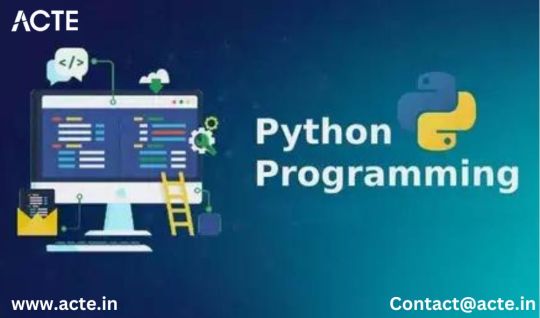
1. Bioinformatics:
Python's popularity in bioinformatics is driven by libraries like Biopython, which empower researchers to process and analyze biological data effortlessly. This includes tasks such as sequence manipulation, sequence alignments, and parsing common genomic file formats.
2. Data Analysis:
Python's data analysis libraries, including NumPy, Pandas, and Matplotlib, are invaluable tools for biologists. These libraries enable the analysis and visualization of large datasets, aiding in the extraction of meaningful insights from biological experiments and studies.
3. Machine learning and AI:
Python boasts a rich ecosystem of machine learning and artificial intelligence libraries like TensorFlow, PyTorch, and scikit-learn. These libraries play a crucial role in tasks such as image analysis, drug discovery, and genomics research.
4. Web Development:
Python is instrumental in creating web interfaces for biological databases and analysis pipelines. Frameworks like Django and Flask are commonly used to build bioinformatics tools and applications.
5. Biological Simulation:
Python, through libraries like BioSimPy, enables the simulation of complex biological processes and models. This aids researchers in gaining a deeper understanding of various biological phenomena.
6. Visualization:
Python's visualization libraries, such as Matplotlib, Seaborn, and Plotly, empower biologists to create informative and visually appealing charts and plots for presentations and publications.

7. Data Handling:
Python's extensive libraries simplify the handling and manipulation of diverse biological data types, including DNA sequences, protein structures, and experimental results.
8. Collaboration:
Python's simplicity and readability make it an ideal language for collaborative research in biology. Its code is easily shareable and understandable among researchers.
9. Community and Resources:
Python boasts a supportive community of bioinformaticians and biologists who actively contribute to open-source projects, share code, and offer assistance through forums and mailing lists.
In this case, Python provides a unique greeting once you inquire about the user's name.
Free and Open Source:
Python is completely free to use. You can download it from the official website (python.org) and start writing code without paying anything. Plus, it's open source, which means a global community of developers continually improves and maintains it.
Huge community and resources:
Because Python is so popular, there's a massive community of Python enthusiasts. You can find tutorials, courses, forums, and libraries to help you learn and solve problems.
Cross-Platform:
Python works on different operating systems, like Windows, macOS, and Linux. You don't have to worry about compatibility issues when you switch between computers.
In a nutshell, Python is a user-friendly, versatile, and powerful programming language. It's perfect for beginners because of its readability and for experts because of its extensive libraries and capabilities. Whether you want to build websites, analyze data, or create AI, Python is a fantastic choice to start your coding journey. So, why not give it a try? Say "Hello, World!" to Python today!
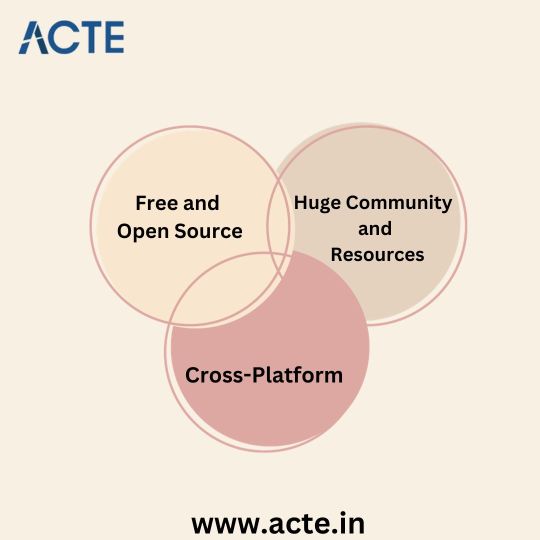
Your Educational Journey For Python Training
ACTE Technologies offers a comprehensive Python program that includes practical exercises, assignments, and real-world projects, ensuring you gain practical experience and a deep understanding of Python. Learn from seasoned Python professionals who provide industry-relevant guidance, setting you up for success in the field. ACTE Technologies assists in job placement, leveraging their connections with employers to help you secure Python-related positions. Choose between offline and online Python classes to accommodate your schedule and learning preferences.
Python is an indispensable tool in biology, driving advancements in research and analysis. ACTE Technologies is your partner in mastering Python, offering comprehensive training and support to help you unlock the doors to a rewarding career in the fields of bioinformatics and computational biology.
1 note
·
View note
Text
Best Digital Marketing Ai Tools To Leverage In 2023

In today’s rapidly evolving digital landscape, staying ahead of the competition requires businesses to embrace cutting-edge technologies. Among these technologies, artificial intelligence (AI) stands out as a transformative force, revolutionizing the way digital marketing operates. AI-powered solutions offer immense potential for streamlining operations, enhancing consumer interactions, and optimizing marketing initiatives.
To achieve their marketing goals, companies can leverage the most effective AI tools available in 2023
1. Hootsuite: Hootsuite is a well-known AI-powered social media management tool that enables businesses to efficiently handle their social media presence. Its features, including content planning and sentiment analysis, allow businesses to monitor brand mentions, engage with their target audience, and gain valuable insights from social media data. Hootsuite is a valuable resource for improving social media campaigns and boosting engagement on various platforms.
2. IBM Watson: IBM Watson is an advanced AI platform tailored for digital marketers, offering an extensive selection of tools and services. By utilizing Watson, marketers gain the ability to understand unstructured data, create personalized customer experiences, and automate customer care interactions, resulting in impactful and efficient marketing campaigns.
3. Mailchimp: A popular email marketing platform named Mailchimp uses AI to improve its services and send out personalized emails. Marketers may increase user engagement by automating email sequences and creating dynamic content that adapts to user preferences employing AI capabilities. Businesses could boost the effectiveness of their email marketing through the use of Mailchimp’s AI solutions, increasing client conversion rates and their overall marketing performance.
4. Adext AI: Adext AI is a machine learning-driven digital advertising platform that uses AI to optimize ad campaigns across several platforms. Adext AI continuously evaluates audience behavior, campaign performance, and conversion statistics to flexibly allocates budgets and modify targeting parameters in real time. By using this effective tool, marketers may improve campaign results and maximize their advertising ROI.
5. Sprinklr: Sprinklr is an AI-driven tool for managing the customer experience that helps firms handle interactions across various channels. Marketing professionals can utilize Sprinklr to offer tailored experiences, track customer journeys, and gather data on client preferences. Through personalized and meaningful interactions, marketers can increase customer engagement and promote brand loyalty with Sprinklr.
6. Botify: A crawlable, indexable, and generally performant website can be improved with the use of the artificial intelligence-based SEO tool named Botify. It uses AI algorithms to examine website data to identify opportunities for improving site speed as well as technical SEO issues like broken links and duplicate content. By adopting Botify, businesses may enhance the technical parts of their websites and raise their search engine presence.
In a Nutshell:
Digital marketing companies can grow substantially while maintaining a competitive edge in the ever-changing digital world by harnessing all the potential of these AI tools. These tools provide businesses with the ability to gain valuable knowledge, promote consumer engagement, and produce data-driven decisions which are well-informed.
iDigitize Infotech LLP is the best digital marketing agency. Visit our website to explore a vast array of informative blogs on digital marketing. Stay informed about industry trends, learn best practices, and discover innovative strategies to drive growth and engage customers effectively.
0 notes
Text
My analytical process in a nutshell:
D&A interaction in sequence is about 1.5 seconds long but we turn it in unnecessarily looooong post. Challenge accepted© AeEmpress

Anyway, I have my midterms, and I don't even know if I fucked up or yeah, exactly I fucked up for sure even though still got chances to manage somehow. Oh, c'mon, I'll handle it like champ, as always just a little nervous a bit.

....Anywizzle.
I want to return to my analysis stuff and do it properly but exams is my top priority right now.
And I have badass fic in mind, that I developing right now but it will be big as hell for sure, but my grammar is even more broken than the Lair in the last episode, so, uhhhh...
P.S: support is appreciated
#rottmnt#aprilxdonnie#rise of tmnt#rottmnt apritello#apritello#me#midterms will fuck me hard i guess#god give me strength#god give me patience#god give me brain#analysis my beloved i miss you#i've got a fanfic idea and it's great
28 notes
·
View notes
Text
187. daffy duck & egghead (1938)
release date: january 1st, 1938
series: merrie melodies
director: tex avery
starring: mel blanc (daffy, turtle, duck), danny webb (egghead)

starting off the new year with a bang—the first cartoon of 1938 is one of my favorites! two tex avery creations, daffy and egghead, make their second appearances paired together.
both characters have gotten a makeover, though egghead’s is more drastic: he now has hair and talks in a dopey drawl courtesy of danny webb. daffy, on the other hand, now has blue irises and a matching ring around his neck—this design would be exclusive to this short only. but, it IS the first cartoon to pen him as daffy duck! he’d appear in a number of looney tunes shorts with porky as the year would go on.
like so many other “hunter vs prey” shorts, egghead is determined to hunt daffy. daffy, however, is prepared to do everything in his power to make egghead miserable.
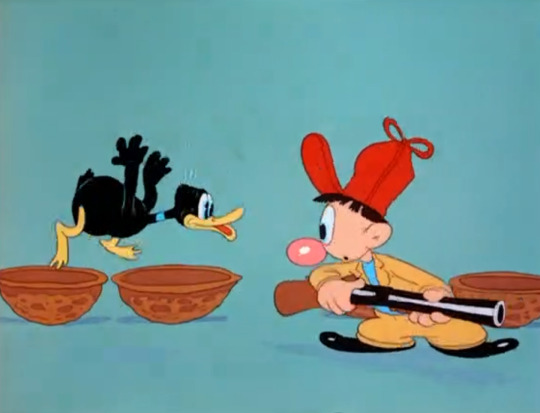
ben hardaway, who would have been directing his own cartoons at the time of this cartoon’s release, is the writer, and it shows throughout. ben is notable for his more hayseed sense of humor, relying on puns so corny you’ll be flossing your teeth for a week to remove the kernels. his punny touch is noticeable right at the start, with daffy and egghead bursting out of literal nutshells in an odd little introductory sequence. irv spence does some nice animation here: daffy shakes his fists in the glory, soon to be interrupted by the fire of egghead’s gun. egghead chases after a HOOHOOing daffy, the smoke from the gun spelling out to the audience “DUCK SEASON STARTS TODAY”.
the scene is odd, but more so out of uniqueness rather than perplexity. one wonders how tex really would have prefaced the cartoon if he were paired with another writer instead.
in a tradition that would carry out into tex’s MGM days, one of our first impressions of the short is a facetious disclaimer:
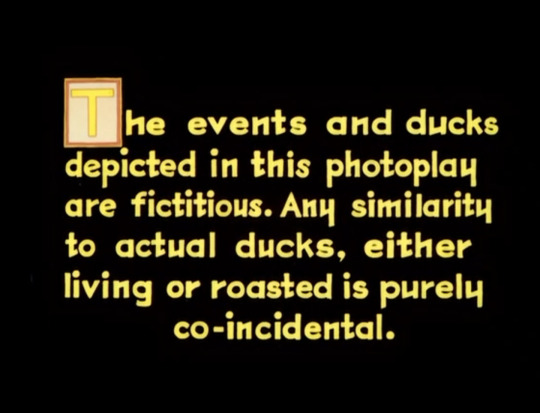
a sense of tranquility is established through a soft, sweeping rendition of “morning song” from the william tell overture. various gorgeously painted backgrounds fade into each other to convey the passage of time and rise of the sun, each background absolutely stunning in its own right. in a tex avery cartoon, such peace and harmony can only mean one thing: chaos is soon to follow.
our eponymous hunter creeps onto the screen, remarking aloud on the eerie stillness of his surroundings. “i wonder if there are any more hunters out here this morning.” right on cue, a swarm of hunters pop out of the reeds, reciting a popular catchphrase from the ken murray show reused in many a ‘30s WB cartoon: “whoooooooooa, yeaaaaah!”
the sound of quacks ring out from the recesses of the reeds, turning egghead on the alert. just as he prepares to hunt his prey, a signature avery gag of epic proportions interrupts the scene... literally.
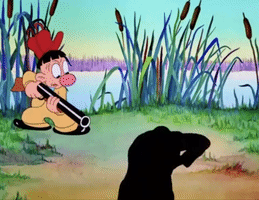
tedd pierce’s silhouette darkens the screen as he makes his way to his movie seat--a latecomer. egghead spots him and urges him to sit down and not scare away his prey. the latecomer does so, only to rise up again and change seats. our frustrated sportsman urges the silhouette to sit down again, which he does so. the silhouette never utters a word, and that’s the best part. the matter of fact delivery of the gag, the control of it all is what makes the gag so funny. such even temperament from the silhouette juxtaposes starkly with the wild nature of avery cartoons. the normal is now the ridiculous.
when the silhouette snoops around for a better seat once more, egghead loses all patience and fires his gun straight at the silhouette. tedd pierce’s theatrics are hilarious--he twirls around, clutching his heart, hamming up his injury to the last drop. the anticipatory drum-roll as egghead looks on brings the entire act together. finally, pierce collapses, much to the contentment of egghead. he merely rubs the dust off his hands in a job well done and continues where he left off.
cartoon characters shooting audience members isn’t an alien move in warner bros. cartoons (bugs in rhapsody rabbit, daffy in the ducksters), yet the inclusion of the silhouette and its subsequent dramatics brings a new level of inclusion with the audience. imagine what an uproar this would get in a packed house! it’s a great way to break the barrier between cartoon characters and the audience. WB did a great job of making the audience feel included. hell, a majority of daffy’s character throughout the ‘40s hinges on this! but that’s an analysis for another time.
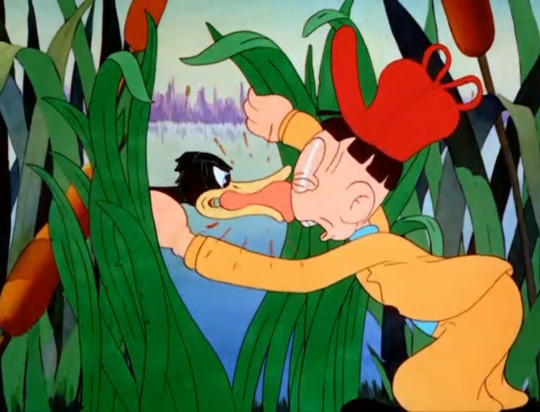
speaking of daffy, he’s the perpetrator of those quacking sounds in the reeds. egghead parts the plants to see if his prey is still there. he is—daffy gives him a viscious bite on egghead’s bulbous nose before going back into hiding.
“that duck’s craaaa-zy!” daffy pops his head out of the reeds again, shrieking a reply of “you tellin’ me? WOO WOO WOOHOO!”
daffy’s voice is significantly more shrill than his dopey guffaws in porky’s duck hunt. in fact, it’s so shrill that this could easily be considered one of his most annoying cartoons. though his 100% screwy, totally out of his mind personality isn’t my favorite personality for him, it’s still pretty damn great! so if you like obnoxious daffy (like me), this is a short for you. if you can’t stand him being a lunatic, stay away!
with that, daffy takes an exit, whooping and shrieking all the way in a direct throwback to his ecstatic exit in porky’s duck hunt. this is a game-changer for the merrie melodies series—the screwy, lunatic antics were typically reserved for the black and white looney tunes shorts. and here we have daffy, splitting the ears of his patrons and being a royal nuisance in the more expensive, esteemed merrie melodies, typically reserved for song and dance numbers! this ain’t your mother’s merry melody.
when daffy takes refuge within a cluster of reeds positioned in the middle of the lake, egghead uses this as an opportunity to lure out his prey with a decoy. specifically, ONE LOVE-LURE DUCK DECOY.
egghead sends the obnoxiously feminine duck decoy out into the water, quacking in time to the beat of stalling’s “the lady in red” underscore. the decoy disappears into the reeds, and there’s a pause.
a flurry of aggravated, warbled quacking cues us in that daffy is pissed off. the action is all hidden behind the plants, leaving details of their altercation is up to the audience’s interpretation. what we do see is daffy’s physical anger: he pops out of the water at the bank of the lake, throwing the decoy down at egghead’s feet. a makeshift sign cleverly held up by a cattail echoes a beloved catchphrase from the radio show fibber mcgee and molly:
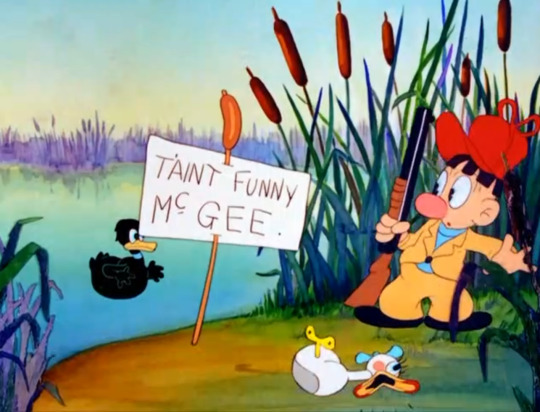
bubbles rippling on the surface indicate daffy’s presence. he pokes his head out to heave a teasing quack at the befuddled hunter before dipping back down again, prompting egghead to stick his rifle in the lake. cue a tried and true gag that was likely much funnier then than now: the ol’ tie-the-gun-into-a-bow trick.
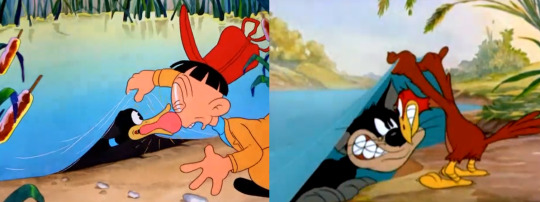
the next gag is one that tex avery would refurbish in his MGM debut, the early bird dood it!: egghead physically lifts the lake up like a blanket, where daffy appears just in time to give his nose another honk for good measure. cue crazed laughter and intricate water aerobics. daffy halts, addressing the audience directly with a flimsy reassurance: “i’m not crazy, i just don’t give a darn!”
irv spence takes the next showdown between hunter and duck. look at how much more appealing egghead is in his hands! egghead leans down to retrieve his gun he tosses aside, when daffy zooms into frame and fights him for it. daffy’s consistent smile as he and egghead battle for dominance, both trying to reach higher and higher on the gun, is hysterical—he’s absolutely getting a kick out of egghead’s frustration. though it was clear he was reveling in porky’s own anger in porky’s duck hunt, here his enjoyment is much more blatant. he loves being a pest.
daffy slides the rifle beneath his legs and out of sight, bopping egghead on the fist and causing him to slug a haymaker against his own head. signature irv spence grawlixes add a nice level of two dimensional graphic design, like something straight from a comic.
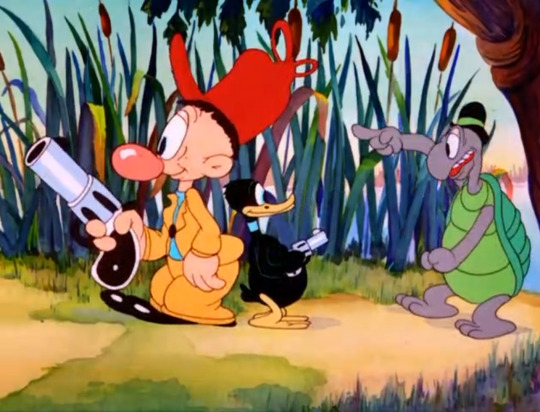
out of nowhere, a random turtle disrupts the altercation. the turtle is a parody of parkykarkus from the chase & sanborn hour, speaking in a thick accent and slightly butchered grammar. he opts to settle daffy and egghead’s fight once and for all, posing as a referee. “just a minute, chums. just a minute!” he supplies the two with pistols, both fitted for their respective sizes. to daffy, “turn around.” to egghead: “now you turn around.”
i love how daffy’s curiosity with the turtle’s interruption is noticeable. so noticeable, in fact, that the turtle grows hostile, getting up in his face and shouting “KEEP YOUR NOSE OUT OF OTHER PEOPLES BUSINESS, AIN’T IT!” it’s rare to see daffy lacking control of the situation, even this early on.
the two put their backs together per the turtle’s command, walking ten paces backwards in time to the turtle’s countdown. just as the turtle reaches ten, daffy jumps behind egghead, who fires. a potentially gruesome conclusion is avoided as the bullet hits the turtle’s chest instead, causing his head to rocket upward, hit a branch, and shrink back into his shell. in a hardawayian touch, daffy hands egghead a cigar, walking off screen, satisfied.
random as the scene is (hardaway’s influence seems to be particularly strong throughout this whole middle section), irv spence’s timing and appealing animation makes up for it. the switch to another animator entails an inevitable downgrade in draftsmanship.
after egghead realizes he’s been duped, he retrieves his rifle and prepares to shoot daffy. though initially startled, daffy thinks on his feet, and eagerly places an apple on his head for egghead to aim at instead. stalling’s fitting accompaniment of “william tell overture” raises in key each time egghead fires (and subsequently misses), a pattern that sounds almost identical to scott bradley’s scores under the direction of tex at MGM.
egghead shoots a tree, the lake, a barn, and even straight past daffy, who grows increasingly irritated at the hunter’s incompetence, moving closer to him with each effort. hardaway’s influence is strong with the next gag, matched with tex’s fast pace to prevent it from overstaying its welcome: daffy thrusts pencils, sunglasses, and a sign that says BLIND on it before turning to the audience and tssking. “too bad. too bad!” harsh indeed. i imagine this gag would have been prolonged had hardaway directed this cartoon or wrote it under another director.
if anything, this cartoon certainly displays the importance of the relationship between director and writer. writers have a much bigger influence on the cartoon than one might believe! there’s a reason as to why chuck jones and mike maltese are touted around as a dynamic duo. i wouldn’t call hardaway a bad writer by any means, but his influence is certainly potent. tex is a strong director, and thankfully he could cushion the blows of hardaway’s corniness as much as he could, but it’s also evident that certain decisions were made that tex wouldn’t have made in other circumstances.

decisions such as daffy singing an entire ode to his lunacy as the cartoon’s song number. this is definitely a hardawayian insert--a prototype, hayseed, screwball bugs bunny sings his own nutty anthem in hardaway’s hare-um scare-um just a year later. full song numbers have been making their way out the door in avery’s cartoons, and by either this year or next they’d be absent in total from the merrie melodies series. it’s unlike avery to write a whole song about characters explaining their nuttiness.
that is why i have qualms with the scene. at his zenith, daffy never attempts to explain or justify his screwiness. even in the mid-’40s, when he’s able to think and speak coherently and isn’t a mere caricature of his name, he showed no self awareness for his condition. the “look at me, ain’t i a crazy one?” jokes with him were out the door by 1939. half the fun with him is how unaware he is of his daffiness--he lives in it constantly, always zipping from emotional extremes, but never stops to tell the audience just how crazy and fun he is. here, his self-awareness seems ingenuine and prideful. daffy is my favorite character for his humanity and relatability (even--if not more so--when he’s a total loon). here, he lacks that dynamism. he’s merely a stock reflection of his namesake.
with that said, daffy’s rendition of “the merry go round broke down” is my favorite merrie melody song number, period. i’m certainly biased due to my undying affinity with daffy, but irv spence’s animation is genuinely fun to watch, and mel blanc does a wonderful performance. i know all of the words by heart! essentially, daffy’s justification for his daffiness is because the dizzy pace of the merry go round went to his head and made him nuts. while this sense of bragging is relatively out of character for him, it makes for a contagiously fun song, and also, this is his second film ever. they still had much to explore.
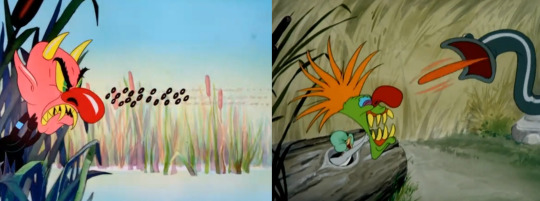
the scene concludes with daffy shaking hands with his reflection in the water and diving back in. fade out and in to egghead, still furiously attempting to pursue his prey. cue a fun little avery gag where our hunter nonchalantly opens the reeds he’s hiding behind like a pair of blinds. daffy’s carefree quacking and swimming in the lake almost seems to mock him. in a gag that would be reused in avery’s lucky ducky over at MGM to a greater extent, daffy puts on a mask to scare away the oncoming bullets. indeed, the bullets retreat into egghead’s gun, prompting befuddled stares at both the gun and the audience.
daffy engages in another round of spastic water aerobics, HOOHOOing all the way. he only pauses to cling to a cattail, echoing an averyian daffy catchphrase that he would also shriek in daffy duck in hollywood, “ain’t i some cutie? ahah! i think i’ll do it again! HAHAHA!”
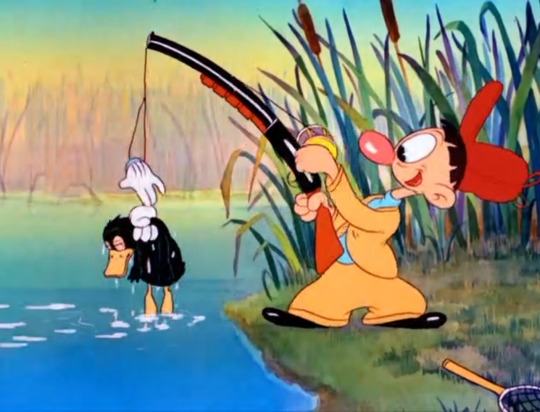
a nice, jazzy score of “bob white (whatcha gonna swing tonight?)” accompanies yet another endeavor by egghead. he’s either stupidly bold or boldly stupid to keep up such a tiring charade--or both! egghead loads a pair of gloves tied to a string into the barrel of the rifle, cleverly using a cattail as a bore brush. and, despite the absurdity of his makeshift fishing pole, it works: one gloved hand grabs daffy by the neck, the other konking him on the head and knocking him unconscious. egghead reels in his prize, dumping daffy into a net and letting out a handful of gleeful “WHOOPEE!”s.
avery’s timing is succinct--immediately after egghead snags his duck, the sound of a siren drowns out his celebration. a duck nearly identical to daffy approaches the scene in an “asylum ambulance”. “gee, t’anks a lot for catchin’ dis goof!” duck confiscates his fellow duck comrade. the decision to turn the conversation confidential, complete with the lowering of the voice and shifty-eyed glances is great. “y’know, we been after dis guy for months!”
despite everything that egghead has endured, he seems genuinely shocked at the duck’s claim that daffy is “100% nuts”. “oh YEAH?” he echoes, daring to believe it. duck nods. “yeeeeah!” with that, he gives egghead a honk right on the nose.
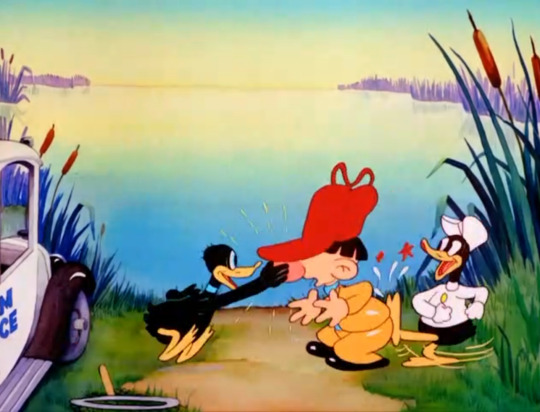
daffy, completely unscathed, wastes little time in joining the festivities as both ducks beat the tar out of egghead from both ends, literally kicking him in the arse and honking him on the nose. both ducks head to the lake, HOOHOOing in shrill unison as they bound off into the horizon. egghead only has one more option... to join them. thus, we iris out on our brave hunter HOOHOOing into the horizon himself.
as i said at the beginning of this review, this cartoon is one of my favorites--for this era, anyway. despite its imperfections, it’s still a rather fun and rousing cartoon. it’s exciting to see daffy becoming more recognizable, in terms of voice, demeanor, and appearance. the same can be said for egghead as well, though i doubt anyone has the same attachment to him as they do other characters. i certainly don’t.
admittedly, porky’s duck hunt is a more solid cartoon. this cartoon feels much more like a string of gags than anything, though i suppose that could be said for many a tex avery cartoon. he wasn’t known for his moving stories. hardaway’s corny, hayseed sense of humor serves as the biggest detriment to the cartoon, but luckily tex is a strong enough director to try and work around those weaknesses as best he could. and even though i disagree with the reasoning behind the song number, the song number will always be my favorite merry melody song.
i didn’t mention the backgrounds very often, but they’re STELLAR. the colorful, whimsical palette brings a lot of energy and vitality to the table. if you were to describe the cartoon in one word, “energetic” would certainly be it.
so, with that said, go watch it! this is a really fun cartoon that serves as an interesting look into early daffy’s character, obnoxious as he may be.
link!
37 notes
·
View notes
Text
Just marvelling at how much personality they squeezed even in the little introduction sequences before you pick your house
The house leaders introducing their classmates:
Edelgard: Attempts fair, balanced, strategic breakdown of everyone's strenghts, weaknesses and interesting qualities including the virtues of the quirkier specimens, though her opinions shine through here and there (she’s noticeably annoyed by Ferdinand and vouches for Hubert’s good qualities) she’s describing the other Black Eagles more from a Pov like “How shall we get them to apply themselves” Dimitri: "This is person X. Person X is awesome. I'm sure you will LOVE person X, you just gotta give them a chance! " He really wants you to like the other Blue Lions going on about how the dodgier ones are good guys deep down and how you’d totally get along with them, mentioning negatives only in a “don’t let this fool you” sort of context. I guess he radiates out the acceptance he hopes to receive. Claude: "Hey check out some funfacts about this one hehehe " but also drops in some tidbits of analysis about the other Golden Deer, and already seems to have extracted many of their backstories and hidden dephts (all the more impressive when you realize he’s only known them briefly, but then again he immediately starts interrogating anyone he meets) He’s not unsympathetic but also not above poking fun at the others in a way the other’s dont.
The house leaders introducing themselves stands out for how ‘show don’t tell’ it is. They don’t go like “Im this and this and this” because no one actually talks like that, instead it’s exposition by their reaction at being asked about themselves and even hint at the sort of dynamic you’ll get if you pick them.
Edelgard: Starts off by rattling off some negative qualities others have ascribed to her. Says she’ll just have to deal with those perceptions. Immediately notes that she perceives herself and Byleth as alike.
“Come here for a gothsy birds-of-a-feather/ us-against-the-world dynamic with this analytic, independent-minded oft-misunderstood lady who values objective perspectives and is maybe a tiny bit fatalist/not the best communicator”
Dimitri: Deflects you, but very badly and awkwardly. The existence of a Tragic Back Story is still transparent as fuck; Hopes you’ll accept him anyways but “understands if you dont”
“Sad huggable woobie boi for sale. Transparently has a lot of feelings. Kinda awkward, repressed, overly polite and doormatsey but also fair-minded. Will accept you despite your weird if you accept him despite his weird.“
Claude: Deflects you, but deftly, by turning the question on you. Tries to draw you in by playing mysterious. Makes for friendly, flowing conversation but tells you absolutely nothing of substance.
“Local clever, charming yet secretive shifty boi with great curiosity wants to know all about you, but also actually be your friend, if you’re up for a conspitatory partners-in-crime dynamic and playing detective a lot “
Like there you basically have them in a nutshell.
#three houses#fire emblem: three houses#fire emblem three houses#edelgard von hresvelg#claude von riegan#dimitri alexandre blaiddyd
1K notes
·
View notes
Text
Art Theories
Theories of Image and Text: Semiotic Theory

The term "semiotic," also known as semiology, comes from the Greek word semesion, which means "sign." It's described as "the analysis of signs and how they are used." Ferdinand de Saussure, one of its founders, described it as the study of "the existence of signs within society." Semiotic started out in the field of linguistics, which then moved into psychology, then evolved in sociology and philosophy, and then finally into the arts. The word semiotic was coined in the late 18th century, but it has a long tradition that dates back over two thousand years, to the development of classical semiotic by Greek philosophers and medieval times. Since the 20th century, semiotic theory gained public attention and has been the subject of investigation and discussion between academics and scholars. Ferdinand de Saussure and Charles Sanders Peirce are two semiotic pioneers who made significant contributions.
Ferdinand de Saussure is a Swiss linguist who is widely regarded as the father of modern linguistics. In a few compilations of lecture notes made by his pupils, he coined the term 'semiology.' The material was then collected and published as a book titled "Course in General Linguistics." In a nutshell, Saussure's theory of sign emphasizes internal structure devoted to cognitive thought process or activity of human minds in structuring the physical (material) or intangible (abstract) signs of their environments or surroundings, including the structure of linguistic signs in the language system that allows them to function as human beings and communicate with each other. (Halina Sendera Mohd. Yakin and Andreas Totu. The semiotic perspectives of Peirce and Saussure: a brief comparative study.2014)
Semiotics in arts have a great contribution in its studies specially in understanding and interpreting arts. It can go back to the very beginning, human language all began in the use of symbolism and signs, Signs and icons are the building blocks of human civilization. Each may represent anything distinct from the other.
------------------------------------------------------------------------------
Vitruvian Man by Leonardo da Vinci

Leonardo da Vinci, also known as a "Renaissance man," creator of the famous work Mona Lisa and many more. Leonardo da Vinci's The Vitruvian man is one of the most famous icons of the Renaissance and is an example of his outstanding scientific drawings. The Vitruvian Man investigates the concept of proportion, expressing Leonardo da Vinci's view that "everything connects to everything else."
“Vitruvian man”, also known as "the proportions of the human body according to Vitruvius," was produced between 1480 and 1492. It is kept in Venice, Italy, at the Gallerie dell'Accademia. Drawn on paper using pen and ink, Leonardo shows a man standing inside a square and a circle with four arms and legs, allowing him to achieve 16 poses at the same time. The Vitruvius man is based on Leonardo's perception of De Architectura, which was written by an ancient Roman architect and engineer Marcus Vitruvius Pollio. Vitruvius’ de architectura inspired a lot of architects, artist, and thinkers. According to Vitruvius, to be magnificent, a building should be symmetrical and proportionate. Both traits can be seen in nature, and the human body is a prime example. which he believed could be applied to architecture in terms of weight, proportion, and symmetry.
The notes along with the drawing, called canon of proportions or proportions of man, elaborately describe the interpretation of the drawing in geometric form. It clearly elaborates the architecture concepts of Vitruvius, as well as Leonardo’s view on proportions and geometry.
------------------------------------------------------------------------------
Golden Ratio

According to research, compositions that use the golden ratio are aesthetically appealing. The use of golden ratio helps in positioning subjects and designing our artworks. Studies show that a person, even when he or she doesn’t or can’t recognize it, is attracted to it. There is indeed something pleasing when seeing proportion among elements.
The golden ratio, also known as the divine proportion, phi, the divine part, the Fibonacci number, and the golden mean, is a mathematical theory that describes the ratio of two sums where the greater of the two amounts is equal to their ratio. It was used by many famous artists like Leonardo da Vinci, Michaelangelo, Dali, Sandro Botticelli, Georges Saurat, and many others. Ratio and proportion go way back in time. The Parthenon statues were crafted by Phidias (490-430 BC), a Greek sculptor and mathematician, who used the golden ratio. Euclid (c. 325-c. 265 BC) described golden ratio as "extreme and mean ratio," which gave rise to the term golden mean. Leonardo Fibonacci (1170-1250) was credited with introducing the arabic numerical method to Europe, as well as his eponymous sequence, which became famous quite quickly. Luca Pacioli invented the term "divine proportion" in the 1500s. Martin Ohm (1792-1872), the first person to use the word 'golden,' invented the golden ratio in the 1800s. The term phi didn't come into use until the 1900s, when American mathematician Mark Barr used the Greek symbol to define the proportion.
------------------------------------------------------------------------------
Futurism

Futurism aims to express art in dynamism and modernity. It was first mentioned in 1909 on the front page of the Paris newspaper Le Figaro by Italian poet Filippo Tommaso Marinette in his Manifesto of Futurism. Futurism was one of the most outspoken critics of the past of modernist movements. This was due to the fact that in Italy, the weight of history was particularly overwhelming. In the futurist movements, elements of neo-impressionism and cubism are used to construct compositions. Some of the most known futurist artists are Giacomo Balla, Umberto Boccioni, and Gino Severini. Following World War I's horrors, many artists moved away from avant-garde concepts like futurism and other pre-war movements in favour of more traditional and reassuring approaches, a practice known as the "return to order."
------------------------------------------------------------------------------
Le Corbusier

Charles-Edouard Jeanneret (1965) is a painter, sculptor, designer, urban planner, and architect. He continually mixed heritage and modernity throughout his career and is considered as the most influential architects of the 20thcentury. His work as an architect is now known as the international icon of the modern movement. Le Corbusier is credited with pioneering Modernist architecture, popularizing open-floor style edifices, widespread use of concrete in urban structures, and a variety of chair and sofa styles. He was attracted to cubism at first, but later switched to the purism movement. He was also a founding member of the journal L'Esprit nouveau, where he wrote his seminal essay The Five Points of Architecture, which was developed in the Villa Savoye in Poissy, France.
In his architecture, he fused the functionalist aspirations of his generation with a profound sense of expressionism. He was the first architect to master the use of rough-cast concrete, a technique that matched his taste for asceticism and sculptural forms. UNESCO has designated 17 of his works as world heritage sites. Le Corbusier devised a set of architecture standards that he used to create his works. Pilotis (pillars), roof gardens, open floor plans, long windows, and open facades are all examples of Le Corbusier's architectural ideals. In turn, Le Corbusier called for an architectural paradigm change. This is due to technological advancements and dramatic changes in living patterns during the nineteenth and twentieth centuries. Le Corbusier was always conscious that as an architect, he wanted to reflect on people as a large social entity, thinking as a visionary and inventor. He had developed cities, had built a city in India with Chandigarh, and had always worked hard to express his idea of urbanism in real architecture. Le Corbusier's urban theories are still the driving ideals of contemporary urban architecture. The impact of Le Corbusier on modern architecture is immeasurable. Almost all modernist architecture and urban planning is based on his ideas, and almost all current thought is simply a continuation of, or dismissal of, his ideals.
------------------------------------------------------------------------------
2 notes
·
View notes
Text
A Summary of the Yandere Panel from Otakon 2019

Hey there everyone, Kai here!
As everyone may know, Julie and I went to Otakon this year and basically dicked around. We didn’t see many yandere related this beside two Yuno cosplayers. But a highlight for yandere related things was a yandere panel that occured on Friday. Unfortunately Julie didn’t go on Friday, but I did.
Here’s a brief summary of the Yandere Panel starring me, Kai.
As anyone can imagine, yes, the yandere panel was wack. It was fan ran and it was just a slideshow of random “yanderes” and some video clips. Surprisingly, it was a packed room.
Kicking things off, the host gave a definition of yandere… quoting from TV Tropes. Sigh… we said this before but we take TV Tropes with a grain of salt since it’s basically wikipedia and anyone can edit it. If you guys want to know how fucked TV Tropes is, they had Gaston from Beauty and the Beast as a known “yandere” for a brief period of time before it was edited out. As anyone can imagine, I nearly had a stroke seeing this. It’s like when a student turning in their college paper and all the sources are from wiki. I’m sure someone out there is thinking “But Kai, you guys use wiki all the time for some anons. Isn’t that hypocritical?” The difference here is that we don’t use wiki for the opinion but for the facts. There aren’t any websites out there who would write out a play by play of an entire story. From there, we take the sequence of events and make our own analysis... we even emphasize that we use wiki and it isn’t 100% accurate. That’s the difference. Anyways, let’s talk about the “yanderes”.
First off, the host showed a picture of Griffth from Berserk and explained why he’s a yandere. Cue my deadpanned expression. First off, the panel said that Griffth had two “obsessions”, which automatically knocked him out of the running. But if you need more evidence: Griffth doesn’t even love his two “obsessions” aka Guts and that one chick. Sure you can say Griffth is obsessed over Guts but not romantically. And as everyone knows, we don’t consider “Platonic Yanderes” as yanderes.
Moving on, the host talked about Homura from Madoka Magika. We already established her as a yandere, so moving on.
The host then talked about Gauron and Leonard from Full Metal Panic. Gauron is a big “eh” from me when I checked out his wiki. They describe him as a psychopath with no compassion. Aka, has no emotion = he can’t feel love = he doesn’t love his obsession making him not a yandere. Not enough information for me to say but I’m leaning that he isn’t a yandere since he holds more of “lust” than love for his target. And we all know, lust isn’t love. Next is Leonard. Compared to Gauron, he sounds more of a yandere due to the fact that he actually forced a kiss on his target. But it’s a big maybe because of not enough information and it feels more like this his target is an after thought while he’s more interested in other things…. So, I don’t really feel he’s lovesick. But idk.
Next the host brings up the girls from School Days. As we all remember, we already state the School Day girls are more like psychopaths or yangires. But one thing to note is that the host showed the killing clip from the anime. It was the first time I ever watched the original clip that wasn’t just a gif or from a yandere AMV. And oh boy, I burst out laughing. Deadass, me and my friend, Charity, were the only people laughing at the clip. I’m sorry y’all but that shit is so dramatic and cheesy that it’s a god damn comedy. The stabbing… the cheesy music… god I nearly lost my mind. I’m glad the music was loud enough that it masked my friend and mine laughter. I’m sure the people sitting around us thought we were nuts.
As a side note, the host mentioned Jin Kisaragi from Blaze Blue as a yandere. My friend turned to me so fast and looked me dead in the eye and said, “This chick doesn’t know what she’s talking about. Deadass, Jin isn’t a yandere. He’s just obsessed with killing his brother but he doesn’t want to fuck his brother. You know what I mean?”
It was at this point I had enough of this nonsense and I didn’t want to waste an hour having my brain cells killed. But right before I left, the hot mentioned Creed from Black Cat as a yandere. Fact checking on that Creed isn’t really a yandere. He’s a straight up narcissist and only obsessed over his target due to his ego and love for power/skill. So he’s not in love or lovesick… hence, not a yandere.
While I never actually finished the panel, it’s obvious to see that the host would just continue spouting out clickbait yanderes. Honestly, I didn’t want the heartburn from the stress of this and I don’t want to get the crap beaten out of me as I whisper to my friend about how kawaii anime girls with knifes aren’t yanderes. So that’s the yandere panel in a nutshell.
But man… if anyone with a mediocre sized fanbase can host a panel, why can’t us? Next time otakon comes around, Julie and I will see if we can host our own yandere panel. (Partly joke, partly serious)
Bonus pictures from the con:
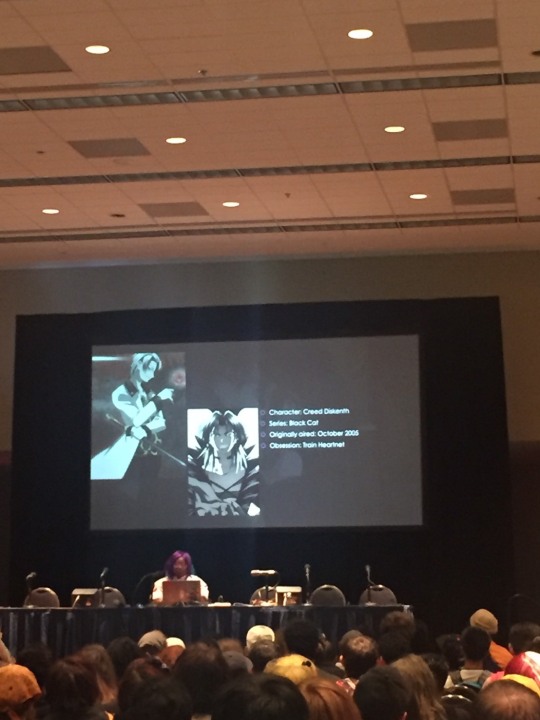

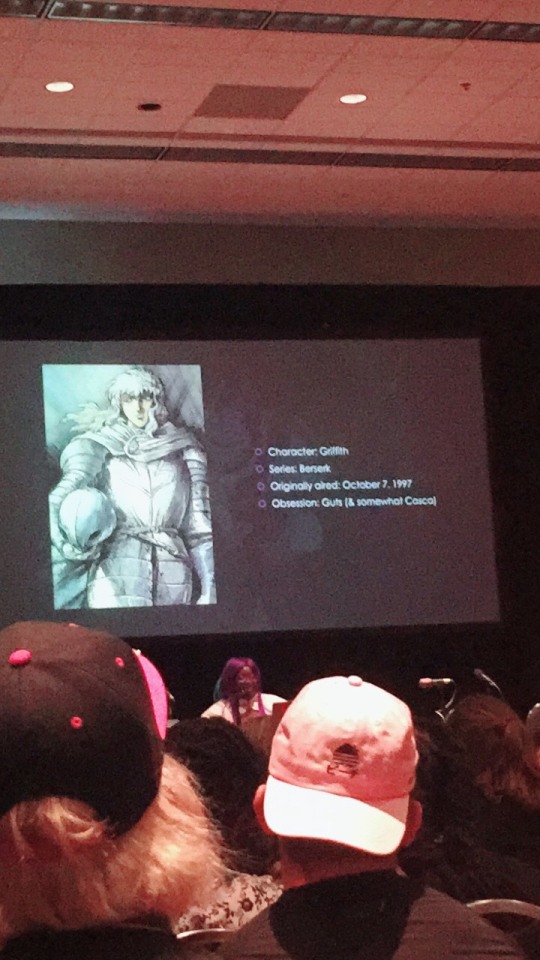
#YandereAesthetics:

14 notes
·
View notes
Text
a jar of happiness in a nutshell, sis (a film review)
Amélie, an isolated woman, hears about Princess Diana’s accident lead her to a memorabilia box that would change her isolated life forever. “Le Fabuleux Destin d’ Amélie”, a 2001 French-romantic comedy film by Jean-Pierre Junet, revolves around a woman named, Amélie Poulain, born in Montmarte and a waitress at The Two Windmills— who grew up as an introvert but an imaginative and creative one, for ever since her childhood, she was only surrounded by her peculiar parents, her only friend— a goldfish, which was thrown away by her mother leaving her alone by herself. One night, as Lady Di, the Princess of Wales, died in a car accident, dropped a perfume-stopper rolled upon a wall tile and found a memorabilia box that impelled her to find its owner. From then on, as Amélie felt sudden contentment, she started fixing people’s messy lives— to sprinkle happiness and joy upon them. However, as she met Nico Quincampoix, a quirky guy who collects peoples’ torn and discarded pieces of photo booth pictures at Gare de l’Est ticket hall and was enchanted by him, Amélie began to feel anxious about her happiness as she struggles alone in her life. Le Fabuleux Destin d’ Amélie shall be watched for it was able to uniquely portray that patterns of life and innate human nature of inevitably craving for dreams, pleasure, love, and happiness to feel alive.
First of all, this film was something to be enjoyed and reflected on because of its fanciful narrative elements which are the following points; (1) the plot was well-devised that can provide the viewers to be enticed on the flow of its narrative. Starting from presenting Amélie’s childhood background or Amélie as a child [e.g. the physical environment, norms, habits, etc.] going to the core and connecting it to the protagonist’s conflict— which is “Man vs. Self” , that was deeply presented as she grew up by seeing how Amélie struggles in socializing and forming connections with people around her causing to resort on dreaming and trying to orchestrate events on the lives of the other characters but hesitant or unconscious of reciprocating it to herself. Moreover, it gives amusing scenes on how Amélie’s curiosity directed the happenings on the film. Also, (2) the use of an omniscient third point of view, an all-knowing one, as if Amélie’s journey was being watched by someone made the story more appealing. By the means of an omniscient narrator, it emphasized that an audience is expected to see a drastic change that would happen in the protagonist’s life— for at some point, it tells clichés in the story but not in an annoying way, [e.g. “Finally, on the night of August 30, 1997, comes the event that will change her life forever.”] leading a viewer to be more intrusive and intrigue by observing each step of Amélie. It also made the film wittier as someone was narrating each characters’ fetishes or quirks— giving the viewer such hints about their secrets or individualities that indeed, pleasure is innate to humans— and with those, it can actually raise a comparison between the other characters vs. Amélie by highlighting the differences of the general pleasures vs. hers. Another point, (3) the symbolisms which showcased significance on the development of its whimsical story are the following; (a) the treasure box or the childhood memorabilia of Dominic Bretodeau, who was a father longing for his childhood memories and his child, was the starting point of everything— it was the most influential thing in Amélie’s life because it is where she was able to suddenly feel a complete harmony within herself causing the events to flow naturally, (b) the painting of Raymond Dufayel, one of her neighbors whom described as The Glass Man, pertaining to Amelie as the girl with the glass water whom Dufayel can’t capture for he feels she’s an outsider, this symbolizes that Amélie, is an art on process— that is still needed to be released from her isolated realm making it more substantial and interesting to await for Amélie’s change, (c) her habit of skimming stones on the river, the movement itself, portrays sequence that once perfectly thrown can create continuous momentum and (d) the photo album of Nino Quincampoix, if it wasn’t because of this, she wouldn’t have the chance to fall in love with somebody as what Gina, Amélie’s fellow waitress said, [“Love is a great beautician”] and nothing would make a difference in her life. Thus, those components made the narrative well-composed, valuable and effective for people like seeing someone changing for good.
Second, its cinematography. It was tremendously apparent that this film’s cinematography used a lot of extreme close up shots using center and rule-of-thirds framing, to accent the significance of character’s facial expressions [wincing, smiling, crying, etc.], bodily movements in almost every scenarios creating a comedic and serious vibe and effectively presenting emotions [e.g. pleased, ecstatic, disgusted, awe, grief] of the characters for the details— not just details but extreme ones of their expressions were indeed, accentuated. One of the best scenes of extreme close-up in this film was the opening remarks, where it showed frames of portraying Amelie’s childhood giving the viewer a glimpse of the protagonist’s isolation for it was clear that she was just only enjoying her own company as well as, the innocence of youth. Some techniques that leading to this kind of shot was starting from a wide-angle shot then suddenly zooming in or tilting the frame as it introduces characters, complimenting a deeper analysis on their personalities and characteristics [e.g. fetishes, likes, dislikes, habits, etc.] Furthermore, it was also used for the objects that serve as clues or hints on Amélie’s complex schemes of dwelling into people’s lives— which is really interesting. Another example, the use of panning and combining it with center framing was also recognizable for the sequence of events in one scenario giving the effect of continuous movement of happenings [e.g. young Amélie taking a photo shifted to another character to make it look like it is just really happening naturally and portraying what’s on the environment] it gives a sense of involvement for the viewer which helps to build the intensity of events. The shaky camera technique— which is a unique way of portraying captured moments and how rapidly things are happening. This can be observed on some montage on the films [e.g. Amélie going to the train station and the last scene, where Nico and Amelie were riding in a motorcycle]. This kind of technique is something fresh on my eyes, it’s not a conventional type, as what is written on the former part which makes it unique. Also, Bruno Delbonnel’s color grading was astonishingly aesthetic. If someone would not notice how aesthetically pleasing Le Fabuleux Destin d’ Amélie is, then that someone is probably blind. At the utmost, it is the most critical part of the film that made everything wholesome. The combination and manipulation of vibrant and deeply saturated hues of red, green and yellow set the atmosphere of the film creating a French-vibe, what that context feels like, a dreamy, imaginative, whimsical, fanciful as if you were involved in the love-story of Amélie and Nico, the color grading was immensely, extraordinarily and exceedingly remarkable— setting the mood and the atmosphere throughout the film. The strong visual look of this film was everything, any viewers cannot deny it. The cinematography was meticulously planned and well-executed, I am almost out of words.
Third, to associate different scenes and to maintain its continuous state, this film is edited with the use of creative combinations of transitions. I think the transitions played the role of escalating the sequence of events— (a) how Hervé Schneid, the editor, used whip transitions to exemplify the change of season and time while focusing on one subject, (b) the cut-aways where Amélie got her revenged to the neighbor that fooled her, where there was an exchange of contrasting emotions— where it is obvious that Amélie was having fun messing with her neighbor while the latter was tremendously disappointed with what was happening, the transition made the scene really hilarious, (c) the used of match cuts especially on the scenes when Amélie was counting people who were having orgasms as well as, the scene where Georgette, the resident hypochondriac and Joseph, Gina’s rejected lover was having sex in the toilet room and how it wittingly conveyed the vibrations that the both characters felt while doing the action, I felt that, (d) the cross-cuts that was used to get inside the head of Amélie as she thinks about the pattern of possible actions of Nico making that scene feels extra saddening, and (e) how Amélie’s happiness was conveyed by the means of fast forwarding and jump cuts while riding the motorcycle with Nico, it was so good to feel the happiness of our dear protagonist. However, I think some standard cuts in the film were not consistent for some looks like unfinished and it made the motion looked not so natural— like it became a void to represent different scenes making the transition look odd and not effective.
Overall, Le Fabuleux Destin d’ Amelie, is indeed, a must be watched film for it expounded the following; for the narrative it serves— (1) a well-written plot, (2) the wittingly use of omniscient point of view, and (3) mind-blowing symbolisms, for the cinematography presented— (1) detailed subjects with the use of extreme close-ups while combining it with other angles to create connection of juxtaposed effect, (2) panning which imitates continuous movement and (3) aesthetically pleasing color grading, for the editing— how it used creative combinations of transitions, (1) match cuts, (2) cut-away, (3) cross-cut, etc. indeed, this film deserves its recognition for it would let the viewers to take chances, to take risks, to live our lives in pursuit of happiness. Thus proving that humans are inevitably craving for dreams, pleasure, love, and life to feel alive.

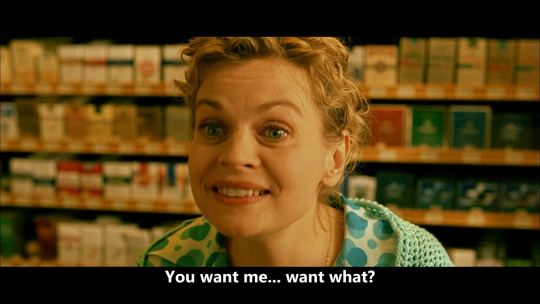
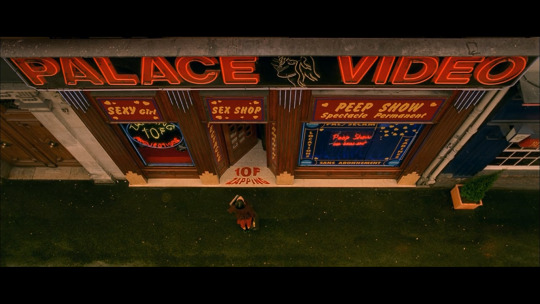

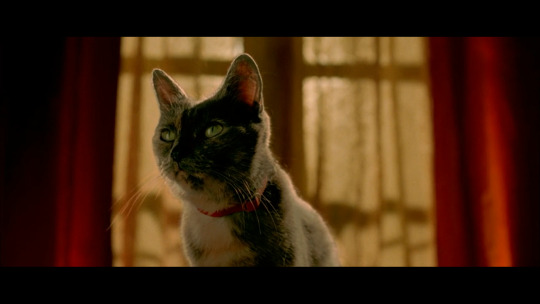

2 notes
·
View notes
Text
A Guide in Making Danganronpa Executions (Mod Syo Style!) [V3 and SDRA2 Spoilers]

'Sup! It is I, Mod Syo coming in with a guide on making the perfect Happy Ending for your Blackened OC's! Kyeeehahahahaha!
Before anything, I'd like to emphasize again that this guide ain't the Word of the Lord. It's up to you whether to take this advice into consideration or naw.
With that put of the way, let's get the ball rollin'!
Canon:
Canon executions in Danganronpa are physically brutal, but its presentation is goofy enough to downplay the fact that a student is experiencing the most painful death they can get. Sometimes, the goofiness levels of the executions are too high that they turn into complete bullshit (e.g. Mikan's execution). It is also presented in a way that even though you refuse to see the death of a fellow classmate, you can't help but watch the entire thing.
In a nutshell, Danganronpa executions are goofy, brutal and visually enticing. Goofiness goes off the charts sometimes.
Mod Syo Style:
Since my style of execution making will make this guide pretty subjective, I'll explain it.
Simply put, I like my executions inhumanely brutal. This is because during the time I was actively writing stories/fanfics, my writing is leaned towards the Slasher genre. Whenever I collab in making a horror/slasher fic, I am always tasked to do the bloodbath/death scenes. I was an edgy child back then, indeed. I will always try my best to correlate the execution to the OC and make it realistically torturous. Unfortunately, the visuals and lightheartedness are lacking due to immense focus on the death itself.
My executions almost always happens in a closed glass dome. It's a coincidence, I swears.
In a nutshell, Mod Syo style Danganronpa executions are brutal and torturous. Visual impact is compromised, however.
A thing to remember is that a good, well-characterized OC makes great executions. Now, on to the creation!
Step 1: Deconstruct Your Character and Choose a Theme
Deconstructing your OC is helpful for picking out good stuff to base the executions from. Now what is deconstruction? It is breaking down something into smaller, more simple parts to get an idea how it is made. Now for OC's, it is a breakdown of an OC into their innermost essence.
How does it help in picking out bases for execution? Simple! By their talents, traits, etc., we can make the themes and their manner of death hit them home as much at it physically hurts (Ah, the wonders of psychology).
Here are some great point of interests to start on!
Point of Interest 1: The Character's Talent
The most used basis for execution is the OC's talent. Most of the time tho, it's not always the case. You'll get plain executions if you base it out of the talent all the time. Plainness will never be memorable.
However, talents can sometimes be a great basis for the theme. A SHSL Horticulturist with a Little Shop of Horrors-esque execution is a pretty good starting point; but that alone won't make the cut. Kaede's execution is also a great example of this. A piano-based Three Methods of Torture execution is brutal and talent-based.
If your OC's talent is their passion, it is recommended to base the execution to their talent somehow. A mocking irony at the moment of their death will send them to despair, definitely.
Point of Interest 2: The Character's Flaws (Weaknesses, Fears)
If you want to be more emotionally hurting, this is a great pick. Making them experience the thing that they desperately want to avoid is cruel, and we're going for that shit.
Take Hibiki and Kanade Otonokoji's executions for example (For those who don't know they are from Super Danganronpa Another 2, a Korean fangame). Presented in a never-seen-before dual execution, Hibiki is beheaded before Kanade's eyes when she thought she was about to save her. Kanade is extremely clingy and obsessive to her older sister, and her dying would be the last thing she wants to happen. Pretty clever.
Point of Interest 3: The Character's Wants
A classic psychological trick. Give the character what they want the most, or seemingly give them a chance to escape; only to snatch that false hope before them.
This is a pretty classic theme in the Danganronpa franchise, as most executions follow this sort of theme. But for analysis purposes, let's check out Celeste's execution.
Celeste likes everything gothic and everything that will not associate to plainness and Taeko Yasuhiro. Her execution is very gothic, from the presentation, to the execution music. But before she gets burnt to death, the oh-so familiar chord progression comes in and a firetruck hits her. Hit and run is a very common way to die, and reminds her that she is nothing but a plain jane that will die a plain way.
The common thing between the three points of interest is all in all the same. Make your OC feel as much despair as possible.
Step 2: Pick a Method of Execution
This proves to be the hardest hurdle to overcome, especially when you don't have a definite theme in mind. When picking out an execution method, take its brutality into consideration. If it's too simple, even exaggerating the entire thing will make it pretty boring and anticlimatic. If it's too brutal, the horrendous amount of blood and gore will make it very cartoonish and goofy. Make sure the entire thing is visceral and grounds into reality. Make the audience feel that the Killing Game they entered is no joke. Or if you choose to make it a bit goofy, emphasize how their lives are only toyed around by the Mastermind. Both are cruel in their own ways, no?
This is a great start to look for executions to base on. User discretion is advised.
https://en.m.wikipedia.org/wiki/Category:Execution_methods?ved=0ahUKEwiA0d-FoufcAhXQbX0KHXtwD5sQypMCCB8wCg
Despite this, don't be afraid to think outside the box! Liquefaction due to intense g force and electrocution is actually a pretty brutal death in itself. The butter is the only thing that killed it.
Step 3: Storyboard It
The entire execution pizzazz won't be complete unless you have storyboarded it. Once you have your theme and execution method as basis, piece them together.
Only one thing to remember, make your execution sequence interesting. Have them watch through the end of it. If you're going for a purposefully anticlimatic end, build up the hype and make sure it doesn't look too forced.
If you went through your finished product and felt that it's pretty boring, revise it because it probably is boring.
And that's it. Hope this helps you~
- Mod Syo
32 notes
·
View notes
Text
Current affairs latest MCQ

Multiple Choice Questions (MCQ) exams with negative marking are the present trends for exams internationally. The exam pattern is feared by some students because your choices look confusing, tricky and risky, particularly when exam preparation is not 100%. Here we'd discuss few ways to boost scores to solve/crack the multiple choice questions (MCQ) based exam.
Having myself passed three of the 20 hottest certification exams (Sun Java, Value Engg, PMP) based on Current affairs latest MCQ format, I've figured MCQ tests are like Driving License Test. These driving tests aren't about whether you can begin engine, put your foot on gas pedal and go. On one other hand, they're about general knowledge of vehicle itself (i.e. exam pattern), navigation skills (when to increase, when to decelerate, have control all the time, do defensive driving), know all traffic symbols & rules- high speed lane is just supposed to overtake (i.e. hurry up with questions only once essential), give way to vehicles when must be safe (skip tough questions to truly save time), look out on road for potholes/obstacles/wetness and decelerate (i.e. watch out for tricky questions and don't fall in traps/distracter), follow drive-test examiner's instruction completely (follow the question's instructions in regards to what is expected from us) and so on. Following are the overall tips on the best way to crack multiple choice question (MCQ) exam:
Before the Exam (during preparation)
1) Thoroughly understand the exam pattern. Know all the parts of the exam and go prepared after evaluating negative marking scheme of exam.
2) Understand yourself i.e. know your strength and weaknesses. Strength lies where you had had the opportunity to answer the questions under 30 seconds soon after sleep during preparation and weaknesses where you had the history of marking wrong choices despite contemplating on questions for 2-3 minutes.
3) Perfect the art of speed, correctness and gut feeling. Know a little bit of probability theory to decide if the odds of success in answering a concern are rewarding or foolhardy. There is only a thin line that separates smartness and foolhardy.
4) Old is gold. Try to fix previous years question paper to know the exam format and to build speed, correctness and understand if your gut feeling is generally right or wrong. One can download the prior year's questions papers from large number of sources online.
5) Remember that MCQ format also tests the candidates differentiating skills. If it's possible to develop the skills of eliminating one or two choices from 4 choices, one is on the road to success. Even though you feel the right choice is not among the choices, select the very best choice.
6) Few calculation based questions could have shortcuts methods to fix them. Similarly, most of the theory concepts can be extremely well learnt using memorization tools. Anyone can recall how easy it is to master the sequence of rainbow colors using VIBGYOR (Violet Indigo Blue Green Yellow Orange Red) acronym. I'd devised a mnemonics list of about 50 such acronym words to remember during my PMP exam with great success (e.g. APES means Alternatives Identification, Product Analysis, Expert Judgment and Stakeholder Analysis and CEO means Collective bargaining agreements, Economic condition and Organization Structure). Speaking about our brain, the potency of the signal they convey is determined by use. The more a particular synapse is employed, the stronger the signal it conveys. Therefore regular practice is vital with this method.
7) Develop time management skills during schooling since it will pay-off handsomely during exams. Like experienced cricketers keep their nerve for long chase, learn to pace your innings correctly. Don't keep everything till the conclusion, finish the exam 8-10 minutes before the schedule to do some sanity checks. Some of the Current affairs latest MCQ questions in exams are intentionally made long-worded to check if the candidates are designed for time pressure. My trick for such questions was previously to see the past sentence of the question first to understand what is obviously being asked.
8) Learn few deep breathing exercises and get it done every hour for 1-2 minutes during exam. It will refresh the mind by supplying excess oxygen. Moreover, yogic breathing exercises are proven to create positive attitude and it's possible to keep consitently the nerves well during exam. For me personally even praying worked wonders during exams.
During the Exam 1) Carefully browse the question. After reading the question, briefly close the eyes and think what was written on this topic in your notes and textbook. Many a times, reading your choices first can mislead you to incorrect answers. The questions are framed to separate your lives wheat from husk (i.e. such that students with inadequate preparation would be lured to select wrong answers-also referred to as distracters. Distracters are nicely worded 'correct looking' choices which are never element of exam curriculum.
2) First one should try to fix the problem since it is even more quickly than method of elimination. If you cannot solve it, then try to remove handful of choices, and then proceed with answering that question (if the negative marking is 1/4 or 1/3 of a correct answer). The odds of answering correctly now are far more than negative marking scheme (the odds of success with one choice elimination is 33.3% and two choice elimination is 50% for 4 choice exam). If all choices looks alien for your requirements, do yourself a benefit by quickly moving to next question.
3) Make sure you read the conclusion of the question i.e. words like Except, Not, Never, Always. Remember two negative phrases form one positive phrase. The options that use words like 'always' and 'never' are usually not the right choice, however do confirm under which narrow circumstances such words aren't suited to an answer.
4) Further to point no. 3 above, also look at the end of choice if among the choices is 'Every one of the above' and 'None of the above' ;.In a fast paced world, sometimes we go too fast in selecting answers to repent later that speed should not be at the expense of correctness. Know that you have to drive within 'city limit' and not try to race on 'Formula One Circuit' ;.Spend time and energy to observe if two choices are correct, then it is most likely 'Every one of the above' and likewise for 'None of the above' ;.
5) Remember that some answers (especially formulas, units, value of constants) for the problem can be around elsewhere in the exam questions. This is quite true for online exams where such things are difficult to avoid. They are like 'extra runs' and you got to take them. Therefore just park such questions for review later.
6) A few questions on the exam have choices almost looking like 'twins' i.e. two choices are identical aside from a phrase or value. Almost certainly such cases, the clear answer lies amongst those 'twins' ;.
7) Whenever you have the question look tricky or difficult, browse the question twice. If you feel the right choice is not given as among the choices or two choices appear to be correct, select the very best choice. Select the possibility that's more descriptive/ qualifying and closely related to the question. Checkout for grammatical clues to fit the question. If your question is in the singular then the clear answer could be also in the singular form and likewise. The answer should completely and directly address the question. In case the choice is just partly correct under specific narrow conditions, then it may not be the right choice.
8) Generally try to attempt theoretical questions first and then questions which needs calculation. Our human nature is such that when we attempt a few confident questions in the beginning then we feel charged with positive energy that subsequently increases our efficiency and speed for the remaining exam.
9) Last but not minimal, stay calm and composed during test. Be confident while taking the test. Don't panic when you yourself have left questions unanswered as no one is perfect and many want to do that. Just ensure that the people you have done are correct and you can get the mark marks.
In nutshell, it's possible to master the MCQ tests by knowing the niche thoroughly and practicing it under simulated conditions a number of times (more the better). If above rules are followed in right earnest, one can easily improve their performance in MCQ based exams.
0 notes
Text
Hr Consultants Pakistan
Whether software, skills, or subject matter-specific certifications, discover out what's essential in your trade and spend money on increasing your data base. As a advisor, it's crucial to remain cutting edge and aggressive in your area of interest, and certifications are a concrete approach to demonstrate your drive. And if you'd like a tool that'll help you do every little thing from tracking incoming leads to reserving conferences and will grow with your small business, try HubSpot. To discover your consulting specialty, think about areas you excel in at work, tasks you've gotten high marks on in efficiency reviews, or hobbies you've mastered outside the workplace.
Children underneath 5 years of age carry forty% of the foodborne disease burden, with deaths every year. The International Society for Plant Pathology promotes the world-broad improvement of plant pathology and the dissemination of data about plant illnesses and plant well being administration. The sociological contexts of food production, access, high quality, and consumption.
2 1.1 Administrative Data
They should respond to requests for knowledge in a means that enables them to decipher and handle different needs as an accepted part of the engagement’s agenda. Another approach is to view the process as a sequence of phases—entry, contracting, analysis, data collection, feedback, implementation, and so forth. However, these phases are usually much less discrete than most consultants admit. Management consulting features a broad range of activities, and the various firms and their members typically outline these practices fairly in another way. One method to categorize the actions is in terms of the professional’s space of expertise . But in follow, as many variations exist within these categories as between them.
Consultants who make assessments for his or her clients usually train and educate employees primarily based on their recommendations for how the group needs to change. Consultants can carry out a variety of duties which will differ significantly depending on the business. In a nutshell, consultants provide skilled opinions, analysis, and recommendations to organizations or people, based mostly on their very own expertise. They’re essentially fixers, serving as objective troubleshooters, and offering strategies to forestall issues and improve efficiency. Celtic Consultants team helps students to make the best overseas training decisions. Our experience in the subject of abroad schooling has made us a time-tested useful resource in serving to students to gain admission for suitable courses in acknowledged universities throughout the Globe.
Study Abroad Consultant In Karachi
The finest professionals encourage purchasers to enhance organizational effectiveness not by writing stories or recommending books on the subject however by modeling strategies of motivation that work nicely. There is no single qualification to changing into a advisor, apart from those laid down in relation to medical, psychological and engineering personnel who have attained this stage-degree in it or skilled licenses. Consultants may maintain undergraduate degrees, graduate levels, skilled levels or skilled designations pertaining to their field of experience. In some fields, a consultant may be required to hold certain professional licenses (e.g., a civil engineer offering consulting on a bridge project could need to be knowledgeable engineer). In other kinds of consulting, there may be no particular qualification necessities. A authorized consultant may need to be a member of the bar or maintain a law degree.
Consultants Group is a staff of Professionals offering a variety of providers in Engineering, Architecture, ProjectManagementand allied Services. Sometimes profitable implementation requires not solely new management ideas and methods but also totally different attitudes regarding management features and prerogatives and even modifications in how the basic function of the organization is outlined and carried out. The term organizational effectiveness is used to suggest the ability to adapt future strategy and conduct to environmental change and to optimize the contribution of the group’s human sources. Managers mustn't necessarily anticipate their advisers to ask these questions.
Information Gov
In these methods, the professional contributes to total effectiveness by addressing instant issues with sensitivity to their bigger contexts. And clients should not routinely assume that consultants who elevate broader questions are solely making an attempt to snare extra work for themselves. To take a look at how the shopper’s immediate concern matches into the entire picture is, after all, the professional’s duty. Viewing implementation as a central concern influences the professional’s conduct of all phases of the engagement.
0 notes
Video
youtube

write my research paper
About me
Write My Research Paper For Me Online
Write My Research Paper For Me Online In case you need to get the best deal and buy a analysis paper for cheap, try ordering upfront. You can buy a high school essay or analysis paper for less than $10/web page. If you want to pay to have your school paper written, it would price you a mere $12/page. The success of this firm rests completely in your assist, which in flip is bolstered by low prices and high-high quality content material. Knowing these rules, or “strikes,” can change your perspective about this section and help you create a comprehensive interpretation of your outcomes. The moves and information from your outline may help to create your Introduction efficiently and with out missing steps. These moves are site visitors indicators that lead the reader by way of the road of your concepts. Each transfer performs an necessary position in your paper and should be presented with deep thought and care. When you determine the territory, you place your research in context and spotlight the significance of your research matter. So lead your reader via your story by writing direct, concise, and clear sentences. Another important aspect of this part is to create a comprehensive and supported argument or a nicely-researched case. We do not encourage or endorse any activities that violate relevant regulation or any school or university insurance policies. Now is your time to enlist the top 2% expertise, handpicked for you, and make your paper ace. For many authors, writing the Results section is more intimidating than writing the Materials and Methods section . If people are thinking about your paper, they're interested in your results. That is why it is important to make use of all your writing skills to objectively present your key findings in an orderly and logical sequence using illustrative materials and text. This signifies that whereas all different sections of the analysis paper use energetic voice, passive voice is still probably the most predominant in Materials and Methods sections. Remember that a shorter deadline may increase the overall price of your order. You can have your paper written with out divulging your real identification. Many college students find it extremely handy because it provides them with a larger degree of financial control. You simply have to order in advance and choose the bigger deadline while filling out the order form together with your instructions. Satisfaction Guaranteed or Money Back Our company is defined not only by the papers we create but in addition by our relationships with prospects, and we wish those to be good. Furthermore, we fully understand that you are already encumbered by steep school tuition and don’t wish to add to your financial load by charging extreme costs. Therefore, we're extending our provide of writing paper assist for affordable. Anonymous Ordering We pride ourselves on offering the most secure writing help on the Web. If you are not totally having fun with your customer experience, get your a refund. All mannequin papers supplied by acemypaper.com have to be properly referenced. By finding the area of interest, you outline the scope of your analysis drawback and enter the scientific dialogue. The ultimate move, “occupying the niche,” is where you clarify your research in a nutshell and highlight your paper’s significance. The three moves enable your readers to judge their curiosity in your paper and play a major function in the paper review process, determining your paper reviewers. Your Results part is the center of your paper, representing a yr or extra of your daily analysis. This means that you need to be selective in presenting data and choose solely those experimental details which might be essential in your reader to grasp your findings. You may need carried out an experiment 20 instances and collected numerous information, however this doesn't imply that you need to present all these data in your paper. You want to differentiate your results out of your data and be able to discard excessive experimental details that would distract and confuse the reader. However, creating a picture or an argument should not be confused with information manipulation or falsification, which is a willful distortion of knowledge and outcomes. If a few of your findings contradict your concepts, you must point out this and find a believable rationalization for the contradiction. Since each paper has its distinctive outcomes and findings, the Discussion part differs in its size, shape, and construction. However, some basic principles of writing this section nonetheless exist.
0 notes